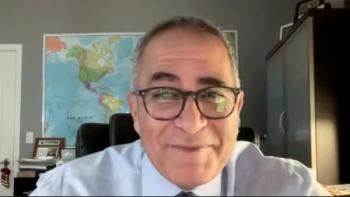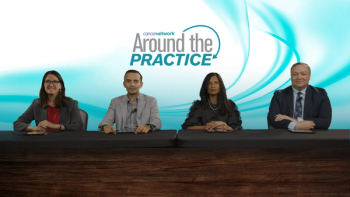
Oncology NEWS International
- Oncology NEWS International Vol 11 No 11
- Volume 11
- Issue 11
Thalidomide Effective as Initial Multiple Myeloma Therapy
PHILADELPHIA-Early reports of the efficacy of thalidomide (Thalomid) as initial therapy for multiple myeloma have been confirmed by researchers at The University of Texas M.D. Anderson Cancer Center, Donna Weber, MD, reported at a symposium sponsored by the University of Pennsylvania and the Multiple Myeloma Research Foundation.
PHILADELPHIAEarly reports of the efficacy of thalidomide (Thalomid) as initial therapy for multiple myeloma have been confirmed by researchers at The University of Texas M.D. Anderson Cancer Center, Donna Weber, MD, reported at a symposium sponsored by the University of Pennsylvania and the Multiple Myeloma Research Foundation.
As sole therapy, thalidomide brought about partial remissions in one third of patients with asymptomatic, previously untreated multiple myeloma at high risk of progression. A combined thalidomide/dexamethasone regimen resulted in responses in more than 70% of patients with symptomatic, previously untreated multiple myeloma, including some complete remissions. These M.D. Anderson results are virtually identical to those previously reported by researchers at the Mayo Clinic.
Remissions produced by either single-agent or combined regimens have been long lasting, and the regimens have the additional advantage of not interfering with subsequent stem cell collection, said Dr. Weber, assistant professor, Department of Lymphoma and Myeloma.
Although final conclusions must await completion of a randomized, controlled trial, combined thalidomide/dexamethasone appears to be among the most active regimens in previously untreated multiple myeloma, she said. Its efficacy approaches that of VAD (vincristine/Adriamycin/dexamethasone) chemotherapy regimens, whose delivery requires an indwelling catheter.
"I feel this oral regimen [thalidomide/dexamethasone] may well be the treatment of choice for previously untreated patients with symptomatic multiple myeloma," Dr. Weber said. A controlled trial of thalidomide/dexamethasone is currently being conducted by the Eastern Collaborative Oncology Group (ECOG).
Refractory Disease
Researchers studying thalidomide in untreated multiple myeloma have applied many lessons learned in previous studies in refractory disease. In these patients, research from multiple centers has shown fairly uniform response rates of about one third for thalidomide regimens and 40% to 50% for thalidomide/dexamethasone (with response defined as a 50% or greater reduction in serum monoclonal paraprotein, a disease marker).
"Thalidomide has not been investigated in a rigorous dose-response trial, but in our experience, nobody who received a dose greater than 400 mg/d had a benefit that we didn’t already see at 400 mg, although I suspect higher doses may occasionally benefit a patient," Dr. Weber said. She noted that studies at the University of Arkansas have previously demonstrated that those patients receiving more than 32 g of thalidomide during a 3-month period had improved survival.
"Our recommendation has been to continue at doses of 400 mg/d or less because of the toxicity that is seen at higher doses," she said. Use of anticoagulants to prevent clots, the most worrisome adverse effect, is controversial.
Encouraged by results in refractory disease, researchers at the Mayo Clinic and M.D. Anderson simultaneously began investigating thalidomide in treatment-naïve patients. Results from the Mayo Clinic have been reported and include partial remission rates of 38% for single-agent thalidomide and 64% for thalidomide/dexamethasone [Rajkumar SV et al: Leukemia 15(8):1274-1276, 2001, and Rajkumar SV et al: Blood 98(11):849a (abstract 3252), 2001].
Asymptomatic Patients
At M.D. Anderson, an uncontrolled trial of thalidomide was begun in patients with asymptomatic multiple myeloma. Patients in the single-agent trial were selected on the basis of two or more markers for increased risk of progression to symptomatic disease (paraprotein levels greater than 3 g/dL, IgA type, Bence-Jones protein levels greater than 50 mg/dL, and an abnormal MRI of the spine).
Previous research indicated that these risk characteristics were associated with median times to disease progression of 18 months or less.
Thalidomide was escalated to a maximum daily dose of 800 mg and continued for at least 3 months or until disease progression. Partial remission was defined as a 50% or greater reduction in serum paraprotein or a 95% or greater decrease in Bence-Jones protein, and complete remission as disappearance of both markers.
Of 28 patients receiving thalidomide, 10 had a partial remission, with a median 4-month time to remission. The 33% response rate is similar to the rates seen in the Mayo Clinic study of symptomatic patients and in most studies of resistant myeloma, Dr. Weber said. A median time to relapse has not yet been observed after an average 21 months of follow-up.
"To show a benefit of thalidomide in this group will take a long time because their survival is longer than the average patient with myeloma," Dr. Weber said. For that reason, it remains premature to recommend single-agent thalidomide in asymptomatic patients.
Symptomatic Patients
The trial of thalidomide/dexamethasone was conducted in 70 patients with symptomatic, previously untreated multiple myeloma. Patients received the same thalidomide regimen as the asymptomatic group, with the addition of pulsed dexamethasone 20 mg/m2 on days 1-4, 9-12, and 17-20. Pulsed dexamethasone was repeated in the second month, after which patients received 4-day maintenance therapy every month.
In these symptomatic patients, 8 complete remissions and 43 partial remissions were observed, for a total response rate of 73%. Responses typically occurred rapidly (median, less than 8 months), and the median time to relapse appears to be greater than 12 months. The complete remission rate appears slightly higher than that seen with many nonmyelo-ablative regimens, Dr. Weber said.
It will be difficult to assess the ultimate effects of thalidomide/dexamethasone because many of the responders have gone on to consolidation with transplants. "We, as well as the Mayo Clinic group, have not had trouble harvesting stem cells after this treatment," Dr. Weber said.
Toxicities
Among the important toxicities of these regimens are constipationwhich should be managed conscientiouslyand neurologic side effects. Of several strategies tried, dose reduction was the only effective approach for neurotoxicity in the M.D. Anderson experience.
The incidence of deep venous thrombosis or pulmonary embolism was relatively infrequent with thalidomide alone but affected 15% of patients on the combined regimen. "Because we had seen thrombosis in earlier trials, we initially tried low-dose prophylactic Coumadin [warfarin] in these patients," Dr. Weber said. At a 1 mg/d dose, Coumadin did not reduce the expected thrombosis rate of about 15%. "We also tried aspirin, but there was no improvement, though others have reported a benefit," she said.
Based on early evidence, low-molecular-weight heparin or Coumadin appears to prevent clots in the subset of patients in whom it has been used, provided therapeutic anticoagulant levels are reached.
Articles in this issue
about 23 years ago
Zoledronic Acid Reduces SREs in Solid Tumorsabout 23 years ago
Study Supports Wider Use of SLN Biopsy in Breast Cancerabout 23 years ago
Minorities Less Likely Than Whites to Receive Good Pain Careabout 23 years ago
Polyglutamate-Paclitaxel Controls Recurrent Ovarian Cancerabout 23 years ago
9cRA Shown to Reverse Premaliagnant Changes in Ex-Smokersabout 23 years ago
FDA Names New ODAC Chairabout 23 years ago
Neoadjuvant Weekly Paclitaxel Effective in Advanced Breast Cancerabout 23 years ago
Docetaxel Plus Gemcitabine Promising in Advanced Pancreatic Cancerabout 23 years ago
Polysaccharides Unique Targets for Immunotherapyabout 23 years ago
Genetic Fingerprinting Shows Distinct Sarcoma SubsetsNewsletter
Stay up to date on recent advances in the multidisciplinary approach to cancer.


![“[This approval] will be a quite dramatic change in our philosophy and practice in multiple myeloma," according to Joseph Mikhael, MD, MEd, FRCPC, FACP, FASCO.](https://cdn.sanity.io/images/0vv8moc6/cancernetwork/3cab3ada4c023b68c118240a512e31d72a7f931b-1200x628.png?w=350&fit=crop&auto=format)

















































































